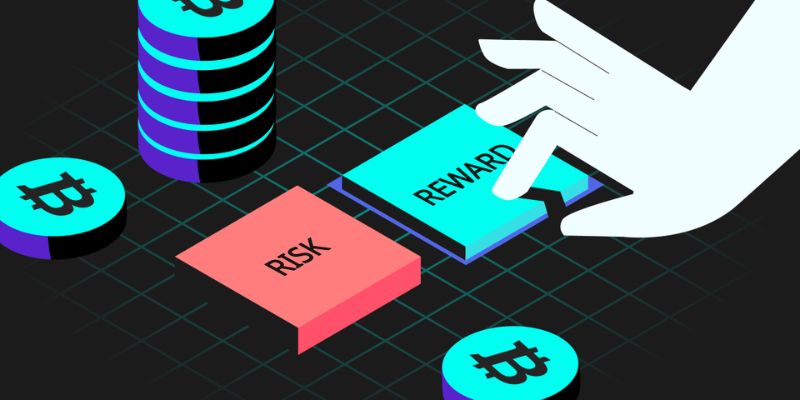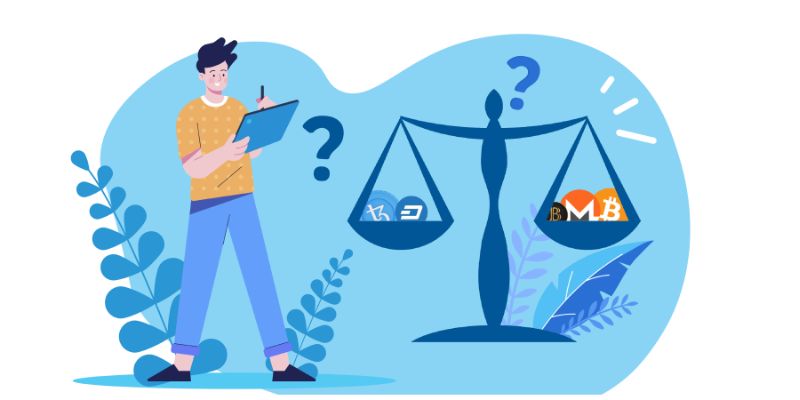Understanding the risks of crypto margin trading is like walking a tightrope above a bustling market square—thrilling but packed with danger. You boost your buying power, but you also ratchet up the risk. In this no-nonsense guide, we dive right into the depths of crypto margin trading, helping you navigate these high-stakes investments safely. We’ll dissect how leverage can be both a powerful tool and a potential pitfall. Join me as we lay out a clear path through the complex world of margin trading, aiming to keep you on top of your game and your investments secure.
The Fundamentals of Crypto Margin Trading
Margin Trading Explained: Reshaping Traditional Investment Strategies
When you hear about people making big wins with Bitcoin, often they’re margin trading. Margin trading is borrowing money for investments. Think of it like a boost for buying more crypto like Bitcoin or Ether. You use a part of what you own (your collateral) to borrow more money. This can make your wins bigger, but your losses too.
So, let’s say you have $1,000. In margin trading, you could borrow $4,000 more. Now, you’re trading with $5,000, not just $1,000. That’s leveraging. If your trade wins, you pay back the $4,000 and keep the extra win. Sounds great, right? But if the trade goes bad, you still owe the $4,000. If it goes really bad, a margin call happens. This means the broker wants their money back now. If you can’t pay, they sell your assets. Yes, even the $1,000 you started with.
Understanding Crypto Collateral: The Fuel of Leverage
Collateral is the money or assets you put down to borrow more. In crypto, you use your coins as this collateral. Exchanges have rules on how much you can borrow. They call this the “initial margin”. If the trade goes bad and your losses hit a certain point, they’ll ask for more money or sell your stuff. This keeps them safe from your bad trade.
Remember, crypto prices change a lot and fast. So, even small drops can mean big trouble when you’ve borrowed a ton. High leverage makes this even scarier. This is why knowing how much to borrow is key. To stay safe, never borrow more than what a sharp price drop could wipe out.
We call crypto a high-risk financial instrument for a reason. It can quickly grow or shrink your cash. Leveraged digital assets sound cool and high-reward. But they’re also high-risk. Like fire, they’re useful but dangerous. Use them right, or you might get burned.
Bell rings, class ends, but here’s your quick homework. Always check the margin rates, and never ignore the dangers of high leverage. Stay informed about exchange policies. And always keep a close eye on that collateral; it’s both your sword and your shield in the arena of crypto margin trading. Remember, a smart trader is a safe trader.
The Hidden Perils of Leverage in Cryptocurrency Market
Liquidation in Margin Trading: The Domino Effect
In crypto, margin trading lets you borrow money to boost your buys. Think of it as adding fuel to your trading power. It’s a way to try for bigger wins using money you loan from an exchange. But it’s risky. Here’s why. Say crypto prices drop hard and fast. If what you owe grows too big compared to your cash at hand, you face a margin call. You must add more money fast or your crypto gets sold off to pay the loan. This selling can push prices down more. It can hit others, causing a chain of sell-offs. That’s the domino effect of liquidation in margin trading.
Now, let’s unpack that a bit. When you trade on margin, exchanges keep an eye on your debt ratio. This is how much you borrowed compared to what you put down initially. If this ratio hits a point set by the exchange, they’ll make a call. They’ll ask for more money or they’ll close your trade to get what’s owed. This is liquidation. It happens fast in crypto because prices move a lot here. It’s vital to watch your trades and have a plan if things go south.
Overleveraging Consequences: When Ambition Meets Reality
Now, what about if you go too big? That’s overleveraging. It’s like packing too much into a bag until it bursts. You want to make a lot, so you borrow plenty. You’re confident and see big gains ahead. But the market can be wild and unfriendly. Crypto moves up and down like a rollercoaster. When you’re overleveraged, a sharp move down means big trouble. Your losses are not just your own money. They now include borrowed cash too. This can turn bad quick and mean a loss beyond what you started with.
To deal with overleveraging, understand where your limits are. Learn from others and from your own trading past. Start with less borrowing and grow as you learn. Know the margin account requirements set by the exchange. Trading with loans means taking care not to drown in debt.
It’s a thrill to chase big returns with borrowed money. But it’s a dangerous game. Always remember, the higher the leverage, the bigger the risk of losing. To trade smart, keep your ambitions in check. Match them with what you truly can handle. Make sure you can back your trades with more than just hope. That’s the key to staying afloat in the risky but potential rich waters of cryptocurrency margin trading.
Managing Risks in High Leverage Crypto Trading
Prudent Leverage Levels: Balancing Reward and Risk
Leveraged trading can feel like a double-edged sword. It magnifies your wins but also your losses. Always start with a low debt ratio. This is the amount you borrow versus what you own. Staying low means fewer risks of big losses.
Ask: What’s a safe leverage level in crypto trading?
A safe leverage level is often low, such as 2:1 or 3:1. This means for every dollar of your own money, you borrow two or three dollars. Keep it low to stay in the game longer. High leverage can lead to quick gains, but losses can also come fast. You don’t want that.
High leverage may seem tempting, sure. It offers the chance to make a lot of money from a small investment. But, it can also wipe out your investment just as fast, if not faster. If the market dips, high leverage can force you into a tight spot, leading to a margin call or even liquidation of your assets.
Protective Measures: Stop Losses and Margin Calls
It’s crucial to set up a stop loss. This tool helps you exit a losing trade at a preset level. It limits your loss. If the trade moves against you, the stop loss kicks in and closes the trade. It’s your safety net in fast markets.
Ask: What’s a crypto margin call?
A margin call is an alert. It says you must add more money to your account or close some trades. This happens when your account value falls below the required level due to losses. You must act fast in this case or risk liquidation.
Margin calls serve as a warning to step back and assess your situation. They remind you to only trade with money you can afford to lose. Protecting your investment should always come first. It’s better to miss out on potential gains than to face the stress and financial strain of a margin call.
In summary, when engaging in leveraged crypto trading, act with caution. Stick to low leverage levels to balance risk and reward. Use protective tools like stop losses. They keep your losses at bay and help you trade another day. And always, always be ready for a margin call. This way, you won’t get caught off-guard and can manage your risks wisely.
Regulatory Impact and Best Practices in Crypto Margin Trading
Cryptocurrency Exchange Policies and Leverage Caps
Every trade is a risk. In crypto margins, it’s like walking a tightrope. Think of leverage as your balance pole. It helps, sure. But lean too much? You fall. That’s the risk when you use borrowed cash to buy cryptos. You want to know how thin that line is? That’s where exchange policies kick in. They set “leverage caps.” It’s a limit on how much you can borrow. It’s there to stop you from falling too hard. It’s like they’re saying, “Whoa, take it easy!” But it’s more than just that—it’s a rule for safety, because sky-high leverage can lead to hard landfalls.
Practicing Responsible Trading in Leveraged Crypto Markets
Ever been told not to bite more than you can chew? That’s key when trading with loans. Margin calls happen when your trade swims with the fishes. Exchanges will holler, “Hey, put more money in or you’re out!” They don’t like losing money, no sir. You need to keep an eye out, have enough to shore up your trade if it sags. And it’s not just about having funds. Keep your head cool, don’t go all-in. Learn the ropes, know your moves. It’s a game where you can win big or lose your boots. So plan your steps, set stops to cut losses, and remember: slow and steady often wins the race.
Always ask, “Can I handle the heat if this goes south?” If your gut yells, “Nope!” then listen. Trading’s a thrill, but your cash isn’t for thrills. It’s for smart moves and protecting your nest egg from cracking. Use your noggin, keep risks low, and you just might come out on top.
In this post, we dove deep into crypto margin trading. We learned how it revamps investing and the role of collateral in boosting our trades. We also tackled the dangers, like how quick losses can spiral from bad trades. And we saw what too much leverage can do—it’s risky business.
We went over keeping danger low in high-stakes trading. This means smart leverage levels and safety nets like stop losses. Then we wrapped with a look at rules and smart habits in leveraged crypto markets, noting exchange rules and caps.
Here’s my final thought: crypto margin trading packs a punch, both in potential gains and risks. Weigh each trade, use less leverage, and always trade with a plan. Stay sharp, stay safe, and keep learning. That’s the smart way to win in crypto trading.
Q&A :
What is crypto margin trading and how does it work?
Crypto margin trading is a method of trading assets using funds provided by a third party. In the cryptocurrency markets, this allows traders to access greater sums of capital, allowing them to leverage their positions. Essentially, margin trading amplifies trading results so that traders can realize larger profits on successful trades. This process involves borrowing funds to increase your bet size, which also increases potential risk, as both gains and losses are amplified.
What are the primary risks associated with crypto margin trading?
The primary risks of crypto margin trading include the potential for amplified losses, margin calls, and liquidation of positions. Since trades are leveraged, if the market moves against your position, you can incur much larger losses relative to your initial investment. Additionally, if the value of your holdings falls below a certain threshold (the maintenance margin), you’ll need to deposit more funds to avoid liquidation of your assets at a potentially significant loss.
How can liquidation in crypto margin trading be avoided?
Liquidation can be avoided by carefully monitoring your positions, using stop-loss orders, and maintaining a sensible level of leverage. It’s essential to understand the maintenance margin requirements and to have a good strategy for managing risk, such as setting up stop orders to limit potential losses or keeping additional funds to add to the margin, should the market move unfavorably.
What is a margin call in cryptocurrency trading?
A margin call occurs when the value of an investor’s margin account falls below the broker’s required amount. In cryptocurrency trading, if the market moves against the trader’s position and the trader does not have sufficient funds to maintain the position (meeting the maintenance margin), a margin call is triggered. This means that the trader has to either add more funds to their account or close positions to reduce the margin requirement.
Is it advised for beginners to try crypto margin trading?
Crypto margin trading is typically not recommended for beginners due to its complex nature and high risk. It is better suited for experienced traders who understand the market and are capable of handling the increased risks involved. Beginners should start with a sound understanding of standard cryptocurrency trading before considering margin trading, and even then, only trade with funds they can afford to lose.



